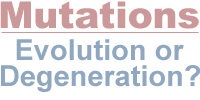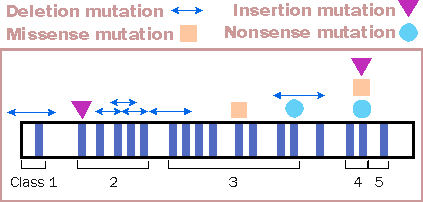Can genetic mutations produce positive changes in living creatures?

Are mutations responsible for evolution from amoeba to man?
Evolutionists have ascribed wondrous powers to mutations, the ability to create new body parts and new animals (amoeba to man evolution).
In reality, mutations are extremely dangerous and are wreaking havoc on the human race and other living creatures.
It is held by evolutionists that genetic mutations are an avenue of positive change in living organisms. For example, Richard Dawkins' book, The Blind Watchmaker, seeks to establish a godless cosmos of chance in which the appearance of design in life has occurred by accident, by the incremental accumulation of positive changes in genes. His evidence relating to biochemical genetics, however, consists of theoretical models of little relevance to the real world.
Thus, the question remains: What do we actually see in the world around us when we use scientific tools of measurement and observation? Do we see this “blind watchmaker” at work in any real-life examples, or do we see the opposite?
The purpose of this article is to demonstrate the poverty of evolutionary theory to explain the facts in one well-researched area of biology--that is, the area of human genetics. It will show how the facts unearthed by this research show mutations to be, not a “blind watchmaker,” but more truthfully analogous to a “blind gunman.”

Literally thousands of human diseases associated with genetic mutations have been catalogued in recent years, with more being described continually. A recent reference book of medical genetics listed some 4,500 different genetic diseases. Some of the inherited syndromes characterized clinically in the days before molecular genetic analysis (such as Marfan's syndrome) are now being shown to be heterogeneous; that is, associated with many different mutations. This review will only scratch the surface of the many recent discoveries. Still, the examples cited will illustrate a compelling general principle which extends throughout this expanding field.
What are mutations?
Mutations are defined as random changes in cellular DNA. They change the genetic code for amino acid sequence in proteins, thus introducing biochemical errors of varying degrees of severity. Mutations have been classified as deletions (loss of DNA bases), insertions (gain of DNA bases), and missense or nonsense (substitution of a DNA base).
If the mutations affect germ cells (female ova and male spermatozoa), they will be passed to all the cells of the offspring, and affect future generations. Such mutations are called “germline mutations,” and are the cause of inherited diseases.
Mutations also occur in other populations of body cells and will accumulate throughout a lifetime without being passed to the offspring. These are called “somatic mutations,” and are important in the genesis of cancers and other degenerative disease processes.
What are the real world results of mutations? (examples)
To survey the mutation problem, it will be helpful to consider a few examples of how mutations work their biochemical havoc.
Cholesterol-related mutations
In the cardiovascular system, it has long been recognized that a high circulating cholesterol content in the blood is associated with degeneration and narrowing of large and medium-sized arteries. this process is called “atherosclerosis” and is a leading cause of heart disease. More recently, a genetic biochemical defect causing hereditary high blood levels of cholesterol has been discovered and is know as “familial hypercholesterolemia” (FH).
This disorder has been traced to mutation of a gene coding a transmembrane receptor protein. The gene is on chromosome 19 and has about 45,000 base pairs with 18 exons. Its encoded receptor protein is anchored in the membranes of all body cells, and allows them to capture and take in “packages” of fats and cholesterol (called “low-density” lipoproteins," or LDL) that are manufactured in the liver. The receptor protein has 772 amino acids which form five functional domains.
At least 350 different disease-producing mutations of the cholesterol receptor have been described. These may be classified according to the affected functional domain.

In the first class of mutation, little or no receptor is synthesized at all. In the second, receptor protein is synthesized, but does not take its proper place in the cell membrane. Third, receptor protein is present in the membrane, but does not link with the LDL packages. Fourth, the receptor protein is unable to stay in the membrane. Fifth, receptor protein is present in the membrane and links with the LDL packages, but does not bring them into the cell. None of these are beneficial.
All body cells need cholesterol for their membranes, so a certain amount is necessary and good. However, defects of this receptor protein result in high blood levels of cholesterol through a feedback loop. When the receptor protein is not working, the cells keep on sending the signals for more cholesterol packages, and the liver complies. In homozygotes, cholesterol levels are three to five times the proper level, while heterozygotes have about twice the proper level. This results in rapid atherosclerosis, sometimes resulting in fatal heart disease in childhood.
Cystic fibrosis mutation
A second example is a common genetic disease, cystic fibrosis (CF). This multisystem disease cripples children and leads to early death. It damages the lungs, digestive organs and, in the male, the vas deferens (spermatic duct). Its differing effects, from mild to severe, are in part due to different types of mutation affecting one key gene.
This biochemical basis is the mutation of a gene coding for a transmembrane protein regulating chloride ion transport across the cell membrane. This gene has 250,000 base pairs and is called the CFTR gene. It codes for a transmembrane protein of 1,480 amino acids. Research on this gene showed a mutation, delta-F508, occurring in most clinical cases of CF. This mutation is a deletion of three nucleotides resulting in loss of phenylalanine residue at position 508 on the peptide chain.
Normal DNA . . . T ATC ATC TTT GGT GTT
Cystic Fibrosis DNA . . . T ATC AT- --T GGT GTT
In addition to this fairly common mutation, over 200 other mutations of this gene have been described. Just a few of these are associated with the more severe forms of the disease, which lead to early death from lung infections. Other mutations or combinations of mutations lead to lesser disease states, like chronic pancreatitis or male infertility, but again, no beneficial results have been observed.
Cancer
As a broad example of disease produced by acquired somatic mutations, let's consider cancer. The link between carcinogenesis and genetic mutation has become much clearer.
Carcinogens (agents causing cancer) also tend to be powerful mutagens (agents producing mutations). The discovery of “oncogenes” and “tumor suppressor genes” has shown how this relationship works. Basically, these genes are concerned with regulation of the cell cycle. The oncogenes drive the process of cell replication forward, while the tumor suppressor genes hold it back. Both are necessary for proper cell function and growth. But mutational damage to components of both systems may produce an uncontrolled growth of cells, which is cancer.
This phenomenon may be compared to a car in which there is damage to the gas pedal, causing it be be stuck “on,” while the brakes are damaged at the same time. These mutations are usually acquired over decades, so cancer is mainly a disease of old age. However, studies have shown that inherited germline mutations of key oncogenes or tumor suppressor genes can predispose persons to development of cancers in childhood.
Examples of this include childhood cancers like retinoblastoma, as well as familial cases of more common cancers (e.g., breast or colon) that have been linked to specific mutant genes (e.g., the BRCA1 and BRCA2 genes for familial breast cancer, and the APC gene for familial colonic polyps and cancers).
Do mutations have any positive results?
With this array of human diseases that are caused by mutations, what of positive effects? With thousands of examples of harmful mutations readily available, surely it should be possible to describe some positive mutations if macroevolution is true.
These would be needed not only for evolution to greater complexity, but also to offset the downward pull of the many harmful mutations. But, when it comes to identifying positive mutations, evolutionary scientists are strangely silent.

Sickle cell anemia
The mutation responsible for sickle cell anemia has been put forward as an example of Evolution. The problems with this are obvious, as the sickle cell mutation, like the many other described hemoglobin mutations, clearly impairs the function of the otherwise marvelously well-designed hemoglobin molecule. It can in no way be regarded as an improvement in our species, even though its preservation is enhanced in malaria-endemic parts of central Africa by natural selection.
Cancerous cellular degeneration
Even more strangely, the process of cancerous cellular degeneration has been vied as a Darwinian form of mutation! Again, this idea fails to hold up under scrutiny. Malignant cells can hardly be considered to be an improvement over their normal counterparts. They are “fitter” only in their replicative activity, but even this is just an exaggerated use of already existing cellular machinery. In many other important ways, they have degenerative features. They show no gain of information, but generally a loss or disorder of functions.
Conclusions
What conclusions may be drawn from these few examples, and countless others like them? First, that the human mutation problem is bad and getting worse. Second, that it is unbalanced by any detectable positive mutations.
To summarize, recent research has revealed literally tens of thousands of different mutations affecting the human genome, with a likelihood of many more yet to be characterized. These have been associated with thousands of diseases affecting every organ and tissue type in the body. The medical descriptions of many forms of inherited disease have a common theme: 80-90% of cases have affected individuals in the family tree, but the remaining cases are sporadic--the result of ever increasing numbers of new mutations. In all this research, not one mutation that increased the efficiency of a genetically coded human protein has been found.
 Instead of a “blind watchmaker,” the mutations behave like a “blind gunman,” a destroyer who shoots deadly “bullets” randomly into beautifully designed models of living molecular machinery. Sometimes they kill. Thus, the “blind watchmaker” is an illusion. Worse than that, it is the intellectual and moral equivalent of an idol--an invention of the imagination, to which superhuman powers are falsely ascribed.
Instead of a “blind watchmaker,” the mutations behave like a “blind gunman,” a destroyer who shoots deadly “bullets” randomly into beautifully designed models of living molecular machinery. Sometimes they kill. Thus, the “blind watchmaker” is an illusion. Worse than that, it is the intellectual and moral equivalent of an idol--an invention of the imagination, to which superhuman powers are falsely ascribed.
Decay and degeneration
This research affirms the reality of the past Biblical curse of decay and degeneration on the world of nature, as stated in both the Old and New Testaments.
It also highlights the grim reality of the future hopelessness of the human race without the saving intervention of God and His Christ. Mutations continue to slowly harm us. Each generation has a slightly more disordered genetic constitution than the preceding one, and no amount of eugenics can reverse this process of decay. Gene therapy may mask the effects, but it will not reverse the underlying degenerative process.
A slight but definite ongoing mutation rate, accompanied by a zero rate of positive genetic change, will eventually turn the human genetic code to gibberish. The problem is like a large book, written with perfect grammar in the beginning, but with random letter substitutions introduced at an ongoing rate. The book will still be readable for some time, but it will eventually lose all sense. Just as the universe is projected to reach a state of maximum entropy, so also the human race is condemned to a degenerative death, not just as individuals, but as a whole.
In conclusion, the Christian hope stands as the only light in the darkness. Only the creative and regenerating work of Christ, as shown in His creation of all things (John 1:3), His miraculous healings, and in His resurrection from the dead, offers humankind true hope for the future.
Author: Dr. David A. Demick, M.D. (pathologist)
More information
- Why don’t mutations help Evolutionists?
- Mutations: Magic Wands or Menace?
- CANCEROUS MUTATIONS—Where did cancer come from?
References
- Richard Dawkins, The Blind Watchmaker: Why the Evidence of Evolution Reveals a Universe Without Design (W.W. Norton and Co., 1987).
- Lubert Stryer, Biochemistry, 3rd edition (W.H. Freeman and Co., 1998).
- C. Koch and N. Hoiby, “The Pathogenesis of Cystic Fibrosis,” The Lancet, Volume 341 (1993).
- Friedman Cohn, et al., “Idiopathic Chronic Pancreatitis and Mutations of the Cystic Fibrosis Gene,” The New England Journal of Medicine, Volume 339 (1998).
- Robert Weinberg, “Oncogenes and Tumor Suppressor Genes,” CA: A Cancer Journal for Clinicians, Volume 44, Number 3 (1994).
- Felix Mitelman, “Chromosomes, Genes, and Cancer,” CA: A Cancer Journal for Clinicians, Volume 44, No. 3 (1994).
- J. Defasche and J. Kastelein, “Molecular Epidemiology of Familial Hypercholesterolemia,” The Lancet, Volume 352 (1998).
- Robbins, Cotran and Kumar, The Pathologic Basis of Disease, 5th edition (Philadephia: W.R. Saunders Co., 1994).
Copyright © 1999, Films for Christ, All Rights Reserved—except as noted on attached “Usage and Copyright” page that grants ChristianAnswers.Net users generous rights for putting this page to work in their homes, personal witnessing, churches and schools.

